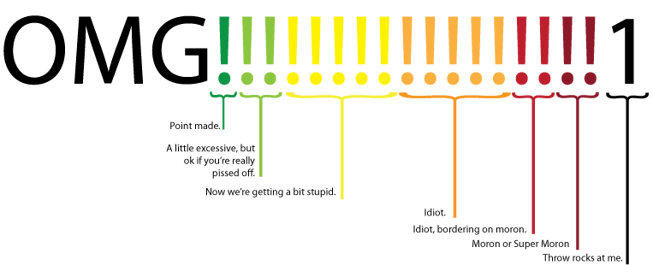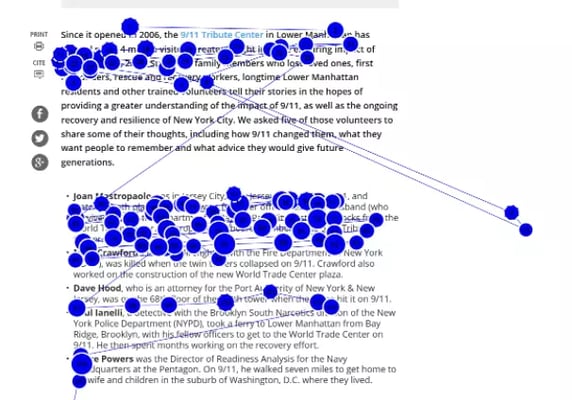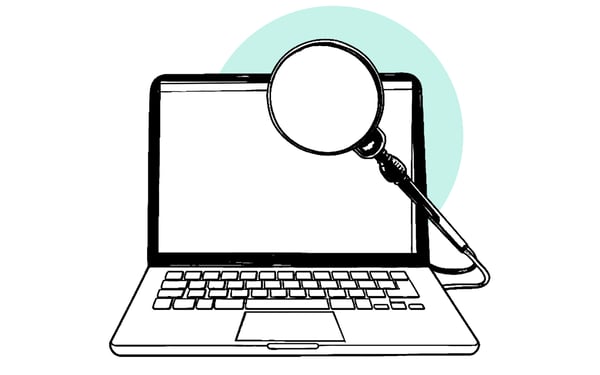
'Have we hit peak punctuation?' asks Megan Garber in The Atlantic. She highlights a growing trend towards excessive, almost epic, levels of punctuation.
At Articulate, we believe that needless punctuation is a speed bump for readers. We’re punctuation minimalists. If you want to start a blog, you should be too.
How people read
Before getting into the dos and don’ts, it’s worth understanding why this whole punctuation discussion is important in the first place. It’s not just a case of writing nerds ranting.
People don’t read text continuously. Instead, their eyes jump forward a few words at a time, every quarter of a second or so.
But about 15 percent of the time, their eyes jump back, often when they don’t understand something or if they trip over some page furniture like unnecessary punctuation.

(Image source)
How people read online
It’s even worse when people go online. Now their eyes are hopping about the page like a barefoot child on hot sand, as you can see from eye-tracking studies.

Our approach, then, should be to minimise everything that gets between our words and the reader’s brain. Here’s a look at the current state of affairs, followed by the recommended punctuation diet.
Peak punctuation
Even as we exhort writers to use fewer, shorter words, people are using more and more punctuation and quasi-punctuation. For example:
- Why use one exclamation mark when three or four shouts even more surprise? ('Prime Rib Saturday!!!!')
- The humble ellipsis ('...') is now a dramatic pause worthy of the Royal Shakespeare Company. ('OK........')
- Multiple question marks have become the equivalent of an arched, ironic eyebrow ('WTF????')
- Then there are smileys, emoticons and emojis. ;-)
This has likely evolved from informal email or instant messaging, where there is a desperate need for emotional context. We're adapting to new electronic media. In fact, Garber argues that new technology - in particular video chat and embedded images - will reduce the need for all those exclamation marks.
Punctuation danger
There is always a danger for writers in becoming too formal and starchy.
It’s a tightrope walk, though. While we strongly believe in a relaxed, conversational tone of voice for almost all businesses, there is an equal and opposite danger in becoming too relaxed. Businesses should avoid over-punctuation and embedding too much context in public copy.
You don't want to sound like a bank manager or lawyer, but you also don't want to sound like a textually challenged teenager.
Lean punctuation
At Articulate, we're well versed in how to edit our copy and are proud punctuation minimalists. Lean punctuation means using as few speed bumps as possible in your text. Our writer's guide has the following advice:
- We don’t capitalise internet or website.
- We use percent not per cent or %.
- We use sentence case for headlines and subheadlines.
- No comma before 'and' in a list, eg ‘One, two and three’ not ‘one, two, and three’.
- Leave one space after a full stop.
- We put full stops at the end of bullet points unless they are clearly not sentences in their own right (eg a list of single words).
- Do not use full stops in abbreviations such as Mr, Dr, eg, ie, etc.
- Spell out numbers from one to ten and anything that is already a number (eg Chapter 7) and percentages (eg 6 percent). Use figures from 11, except at the start of a sentence when they should be spelt out.
- Dates are written like this: 12 March 1969.
- We avoid acronyms unless they are very familiar (eg DVD, PC) or a client product name and we spell out the meaning very clearly.
- Avoid italic text apart from foreign words, unless they are so familiar that they have become anglicised eg status quo, carte blanche, déjà vu, etc. But you probably shouldn’t be using unfamiliar foreign words anyway.
- We use ‘single quotation’ marks for speech and double quotation marks for nested quotations: ‘and then he said “that’s a good idea” all of a sudden’.
- Punctuate the quote as required by the quote and punctuate the sentence as required by the sentence.
We know that some of these choices might be controversial. But we have a good reason for preferring our choices: we want to make it easier for people to read what we write.
Our job is to write for our readers, and make it as easy as possible for them to read, enjoy and remember our copy. Punctuation is like an unreasonably spicy hot sauce. Use it sparingly.








